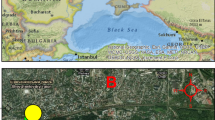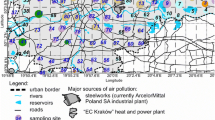Abstract
Our study concerned magnetic properties of soil profiles taken from polluted regions of Eastern Ukraine around the industrial centres Krivyj Rig, Mariupol and Komsomolsk. Soils represent chernozem and podzoluvisol. The low-field magnetic susceptibility shows enhancement in the topsoil caused by contamination by coarse-grain magnetite connected with industrial pollution. Magnetic mineralogy was determined by means of thermal demagnetisation of SIRM, monitoring of susceptibility changes during warming from −196°C to room temperature and heating to 700°C, and Mössbauer analysis. Granulometry of magnetic particles was investigated by determination of hysteresis parameters, susceptibility, M s , SIRM and ARM ratios and frequency dependence of susceptibility. The chemical parameters, namely pH, organic carbon and iron content in different pedogenic and lithogenic minerals, measured for particular horizons determined pedogenic characteristic of soil profiles. Our study showed that differences in magnetic parameters of non-polluted and polluted soil profiles are not limited to the topsoil, but reach deep layers of the parent material. Industrial pollution promotes formation of the so-called “pedogenic” SP and SD particles in these layers.
Similar content being viewed by others
References
Arkhangielskiy, I.M. (1998), Azov Sea — in oceans of problems, who should solved them, Azovskiy Morskoy Al’manakh, Mariupol (in Russian).
Bowen, L.H., E. De Grave, and R. Vandenberghe (1993), Mössbauer effect studies of magnetic soils and sediments. In: G.L. Long and F. Grandjean (ed.), Mössbauer Spectroscopy Applied to Inorganic Chemistry, Vol. 1, Plenum Press, New York.
Cornell, R.M., and U. Schwertmann (2003), The Iron Oxides, Wiley-VCH Gmbh & Co. KgaA, Weinheim.
Day, R., M. Fuller, and V.A. Schmidt (1977), Hysteresis properties of titanomagnetites: grain-size and compositional dependence, Phys. Earth Planet. Int. 13, 260–267.
Dearing, J.A., R.J.L. Dann, K. Hay, J.A. Lees, P.J. Loveland, B.A. Maher, and K. O’Grady (1996), Frequency-dependent susceptibility measurements of environmental materials, Geophys. J. Int. 124, 228–240.
Dearing, J.A., P.M. Bird, R.J.L. Dann, and S.F. Benjamin (1997), Secondary ferrimagnetic minerals in Welsh soils: a comparison of mineral magnetic detection methods and implications for mineral formation, Geophys. J. Int. 130, 727–736.
Dunlop, D.J. (2002), Theory and application of the Day plot (Mrs/Ms versus Hcr/Hc). 2: Application to data for rocks, sediments and soils, J. Geophys. Res. 107, B3, DOI: 10.1029/2001JB000487.
Eyre, J.K., and J. Shaw (1994), Magnetic enhancement of Chinese loess — the role of γ-Fe2O3?, Geophys. J. Int. 117, 265–271.
FAO/UNESCO (1997), Soil Map of the World, Technical Paper 20, ISRIC, Wageningen.
Fialová, H., G. Maier, E. Petrovský, A. Kapička, T. Boyko, and R. Scholger (2006), Magnetic properties of soils from sites with different geological and environmental settings, J. Appl. Geophys. 59, 273–283.
Hanesch, M., and R., Scholger (2002), Mapping of heavy metal loadings in soils by means of magnetic susceptibility measurements, Environ. Geol. 42, 857–870.
Hanesch, M., G. Maier, and R. Scholger (2003), Mapping of heavy metal distribution by measuring the magnetic susceptibility of soils, J. Geophys. IV 107, 605–608.
Hoffmann, V., M. Knab, and E. Appel (1999), Magnetic susceptibility mapping of roadside pollution, J. Geochem. Explor. 66, 313–326.
Jeleńska, M., A. Hasso-Agopsowicz, B. Kopcewicz, A. Sukhorada, K. Tyamina, M. Kądziałko-Hofmokl, and Z. Matviishina (2004), Magnetic properties of the profiles of polluted and non-polluted soils. A case study from Ukraine, Geophys. J. Int. 159, 104–116.
Jordanova, N.V., D.V. Jordanova, L. Veneva, K. Yorova, and E. Petrovský (2003), Magnetic response of soils and vegetation to heave metal pollution — A case study, Environ. Sci. Technol. 37, 4417–4424.
Kapička, A., E. Petrovský, U. Ustjak, and K. Macháčková (1999), Proxy mapping of fly ash pollution of soils around a coal-burning power plant, a case study in the Czech Republic, J. Geochem. Int. 66, 291–297.
Kopcewicz, B., M. Kopcewicz, M. Jeleńska, and A. Hasso-Agopsowic (2005), Mössbauer study of soil profiles in industrial region of Ukraine. In: M. Garcia, J.F. Marco and F. Plazaola (eds.), Industrial Applications of the Mössbauer Effect, American Institute of Physics, Melville, New York, 378–383.
Magiera, T., and Z. Strzyszcz (2000), Ferrimagnetic minerals of anthropogenic origin in soils of some Polish national parks, Water Air Soil Pollut. 124, 37–48.
Maher, B.A. (1986), Characterisation of soil by mineral magnetic measurements, Phys. Earth Planet. Int. 42, 76–92.
Maher, B.A. (1988), Magnetic properties of some synthetic sub-micron magnetites, Geophys. J. Roy. Astron. Soc. 94, 83–96.
Maher, B.A., R. Thompson, and M.W. Hounslow (1999), Introduction. In: B.A. Maher and R. Thompson (eds.), Quaternary Climates, Environments and Magnetism, Cambridge University Press, Cambridge, 1–48.
Malakhov, G., D. Khramtsov, and S. Sivolobov (1993), Geoecology of Kryvorozhsky region and improvement activity, 132 (in Russian).
Medvedev, V.V. (1999), Applying of FAO classification on soils from Ukraine, Bulletin of Agrarian Science 9, 11–17.
Őzdemir, Ő., D.J. Dunlop, and B.M. Moskowitz (1993), The effect of oxidation on the Vervey transition in magnetite, Geophys. Res. Lett. 20, 1671–1674.
Peters, C., and M.J. Dekkers (2003), Selected room temperature magnetic parameters as a function of mineralogy, concentration and grain size, Phys. Chem. Earth. 28, 659–667.
Petrovský, E., and B.B. Ellwood (1999), Magnetic monitoring of pollution of air, land and waters. In: B.A. Maher and R. Thompson (eds.), Quaternary Climates, Environments and Magnetism, Cambridge University Press, Cambridge, 279–322.
van der Kraan, A.M., and J.J. van Loef (1966), Superparamagnetism in submicroscopic α-FeOOH particles observed by the Mössbauer effect, Phys. Lett. 20, 614–616.
Veneva, L., V. Hoffmann, D. Jordanova, N. Jordanova, and Th. Fehr (2004), Rock magnetic, mineralogical and microstructural characterization of fly ashes from Bulgarian power plants and the nearby anthropogenic soils, Phys. Chem. Earth 29, 1011–1023, DOI: 10.1016/j.pce.2004.03.011
Author information
Authors and Affiliations
Corresponding author
Rights and permissions
About this article
Cite this article
Jeleńska, M., Hasso-Agopsowicz, A., Kądziałko-Hofmokl, M. et al. Magnetic structure of polluted soil profiles from Eastern Ukraine. Acta Geophys. 56, 1043–1064 (2008). https://doi.org/10.2478/s11600-008-0036-8
Received:
Accepted:
Published:
Issue Date:
DOI: https://doi.org/10.2478/s11600-008-0036-8




